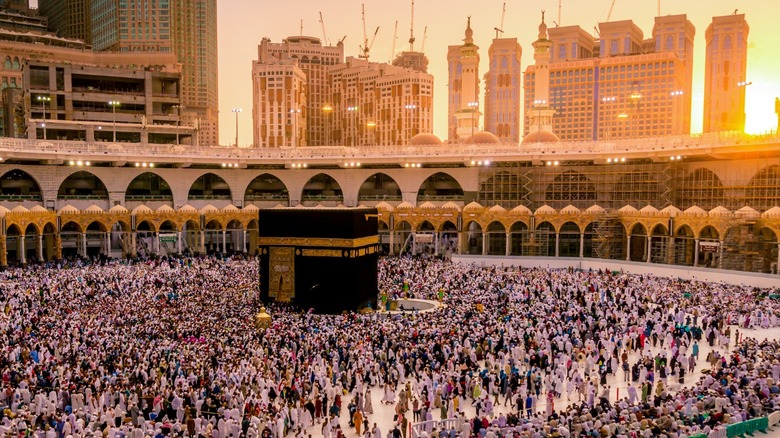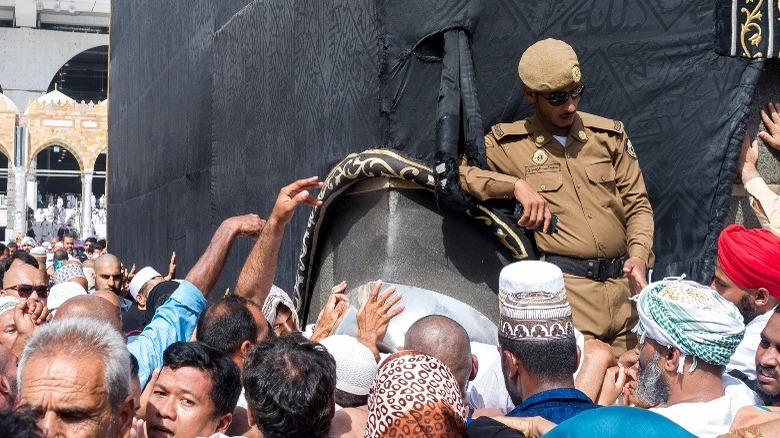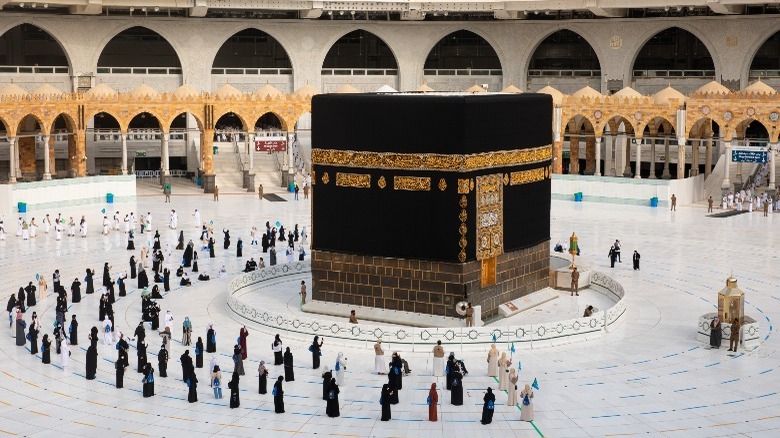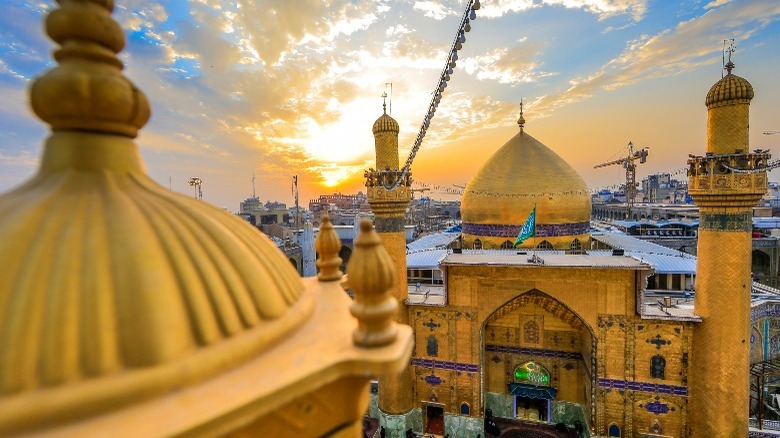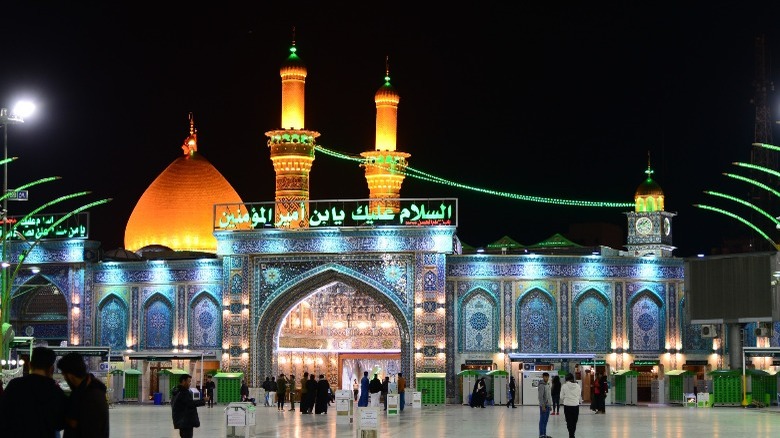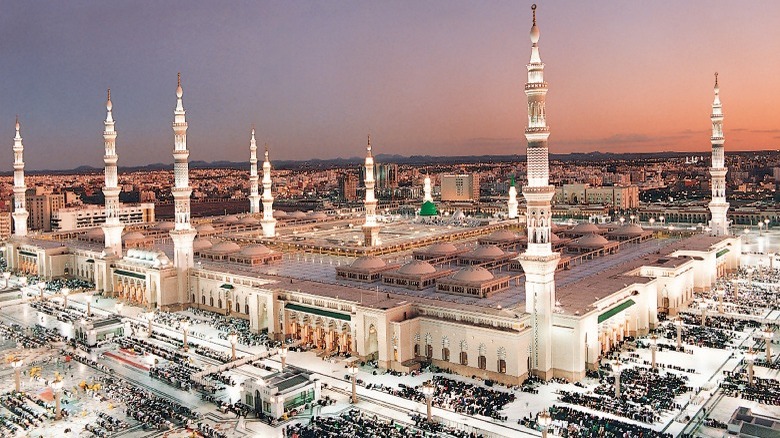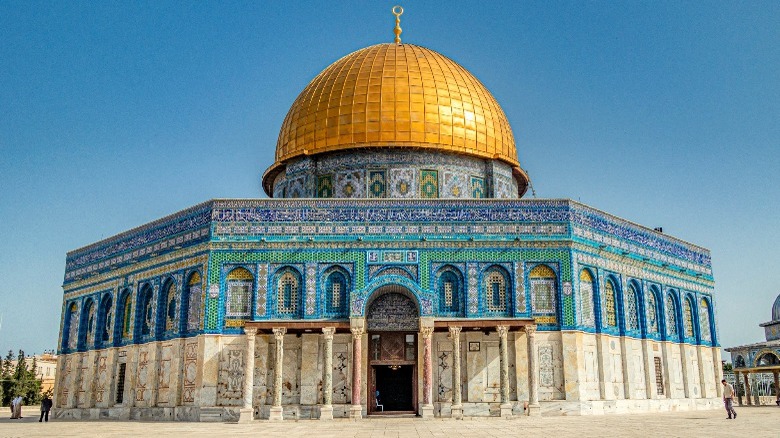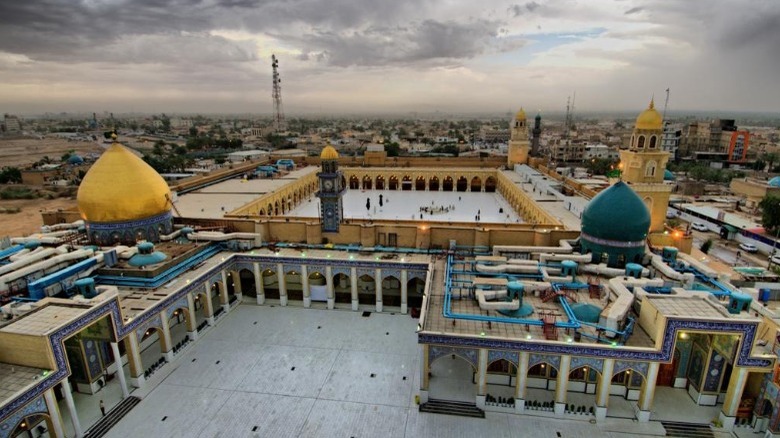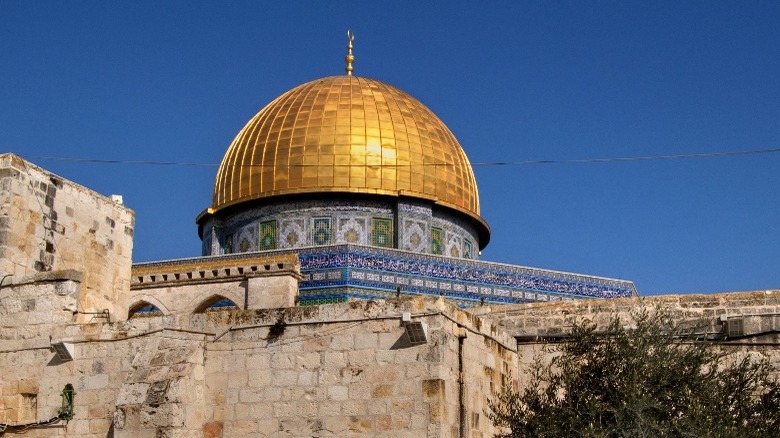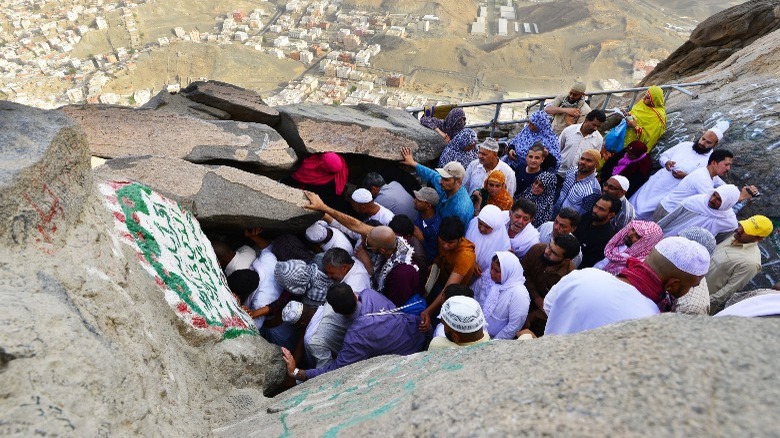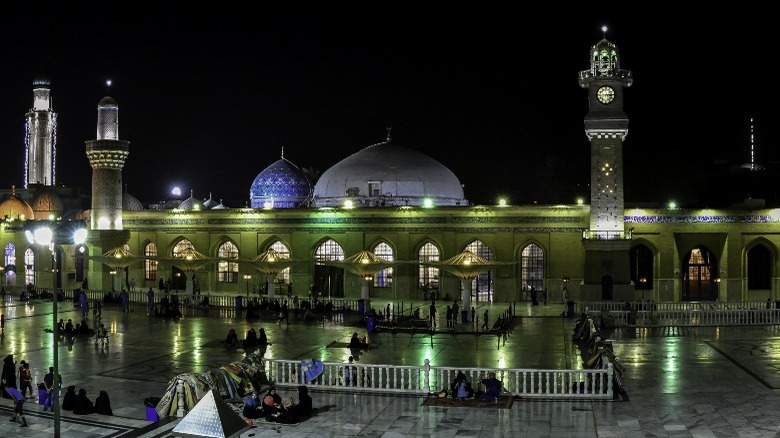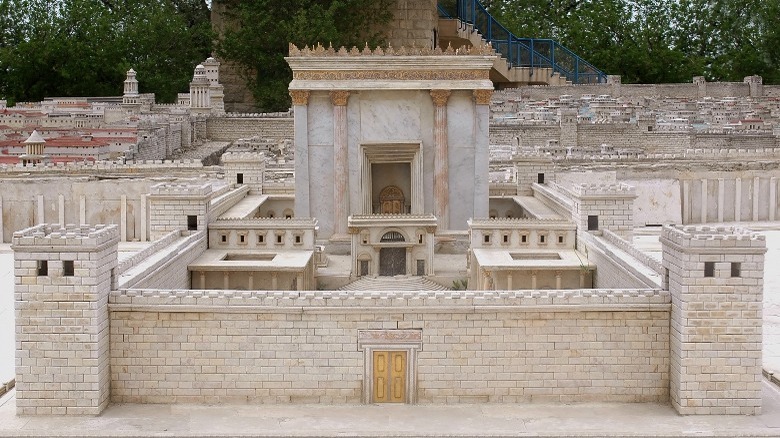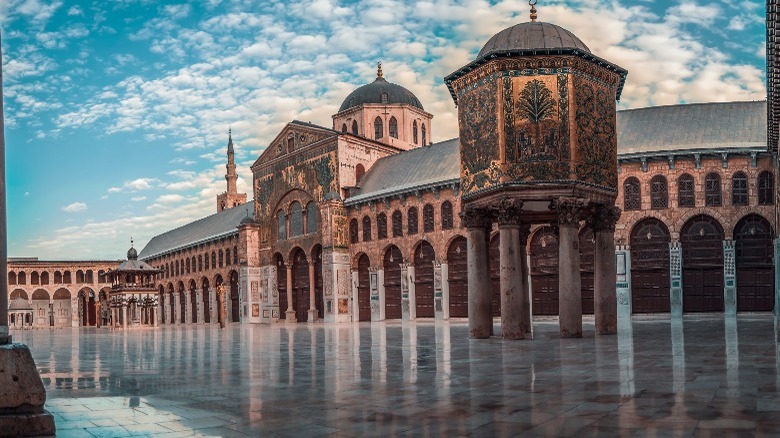The Holiest Sites In Islam
Islam is one of the most popular religions in the world. Behind Christianity, it is the most widespread and practiced religion with more than 1 billion followers, and it has expanded considerably since its origins in Mecca (per "The Complete Illustrated Guide to Islam"). Practitioners of Islam are referred to as Muslims, and the language of Islam is called Arabic. The founder of Islam was the Prophet Muhammad, who created the religion in the early seventh century.
The Prophet Muhammad is the most important figure in Islam, and his teachings are seen as a guide by Muslims on how they should behave and lead their own lives. The central and most sacred religious text in Islam is known as the Quran (or Koran), which was received by Muhammad from God. Apart from the Quran, there are many important Islamic sites that Muslims visit in order to pray and feel connected with Islamic religious history. Many of these sites are located in modern-day Saudi Arabia, Israel, and Palestine, but there are countless others spread throughout the Middle East, and indeed the entire world. Let's take a deeper look at some of the holiest sites in Islam.
The Kaaba: The holiest site in Islam
Of all the sacred and important sites in Islam, the Kaaba in Mecca, Saudi Arabia is by far the holiest. As John L. Esposito explains in "What Everyone Needs to Know About Islam," the Kaaba is particularly revered by Muslims due to its connections with the Judeo-Christian patriarch Abraham (Ibrāhīm in Islam). According to Muslims, inside the cube-shaped Kaaba is the sacred Black Stone. Per Islamic legend, the Black Stone is an ancient meteorite representative of God's covenant with Ibrāhīm.
The Kaaba, which means House of God, is thought to have been first built by Adam (the first biblical human) and is thus the oldest house of worship for the Judeo-Christian God in the world. The original structure was destroyed by the biblical flood and was eventually taken over by the Quraysh tribe. Muhammad is said to have cleansed the Kaaba of the Quraysh's idols and polytheism, thus reclaiming the site for Judeo-Christianity. He placed the Black Stone at the Kaaba as a testament to faith.
Today, Muslims recreate Muhammad's journey to the Kaaba as part of a pilgrimage known as Hajj. They consider the Kaaba to be the Earth's spiritual center, and it is considered a sacred and mandatory duty by all Muslims to perform the Hajj and visit Mecca during their lifetime. Roughly two million Muslims embark on the Hajj annually, and the Kaaba is the first stop on their journey once in Mecca.
The al-Masjid al-Ḥarām: The Great Mosque of Mecca
Housing the holiest site in Islam, the Kaaba, is the Great Mosque of Mecca. Its Arabic name is al-Masjid al-Ḥarām, which means Holy Mosque or Haram Mosque (via Britannica). It is located in the heart of Mecca, Saudi Arabia, and hosts millions of visitors every year. In addition to the Kaaba, worshippers also visit the Zamzam Well in the mosque, as well as the ancient al-Ṣafā and al-Marwah hills surrounding it. As part of the Hajj, worshippers gather in the Great Mosque's courtyard and walk in a circle around the Kaaba as a ritual celebration called ṭawāf.
Most of the Great Mosque was built in the recent past, with the oldest parts belonging to the 16th century. The original mosque was first built in 638 C.E. by some of the earliest Muslims, but there have been constant renovations since. The 20th century saw the most dramatic modernization improvements to the Great Mosque, with comforts like air conditioning, electricity, and a PA system being added.
Another important part of the Great Mosque is the Station of Ibrāhīm (Abraham), also known as the Maqām Ibrāhīm. According to the Islamic cultural website The Pilgrim, the Station of Ibrāhīm is a rock that Ibrahim stood on when he was building the Kaaba with his son Ismail. The rock miraculously rose out of the ground to help Ibrāhīm build the wall.
Ḥaram al-ʾImām ʿAlī: The Mosque of Alī
For Shia Muslims, one of their holiest sites is the Ḥaram al-ʾImām ʿAlī, or the Imam Alī Holy Shrine (also known as the Mosque of Alī) in Najaf, Iraq. According to the "Illustrated Muslim Dictionary of the World," the tombs of biblical patriarchs Noah and Adam are located within the shrine along with Alī, which was first built in the 10th century by Persians. The reason the site is so holy for Shia Muslims is that it is the site where Imam Alī was killed in the seventh century.
Imam Alī is one of the most important figures in Shia Islam (per Britannica). He was the son-in-law and cousin of the Prophet Muhammad and the final of his first four successors. His reign was tumultuous, to say the least, and he consistently had to deal with disputes and internal rebellions. In 661 C.E., Alī was murdered by a poisoned sword, becoming a Shia martyr. He is revered by Shia Muslims due to his connection to Muhammad and is considered by them to be the first Imam — or first descendant of Muhammad.
The site of the Mosque of Alī is built directly where Alī was assassinated — hence its incredible significance for Muslims. Since the mid-20th century, the mosque has unfortunately been occupied at various times by political and military forces, but it is still an important religious site for Shia worshippers.
The Imam Ḥusayn Shrine in Karbala
Another incredibly sacred and holy spot for Shia Muslims is the Imam Ḥusayn Shrine in Karbala, Iraq. According to Britannica, Ḥusayn was the son of Alī, and he did not recognize the authority of his father's posthumous successor, Muʿāwiyah, his son, Yazīd, or the Umayyad Caliphate. While marching to reclaim the Islamic caliphate in favor of Alī's line, Ḥusayn was killed at Karbala in 680 C.E., making him forever a martyr to Shia Muslims. He is considered the third Imam by Shia Islams, after his father Alī and older brother Ḥasan.
Following his death, Muslims started to visit his grave ritualistically, and eventually, the city of Karbala was built surrounding it (per the Islamic cultural website al-Islam). Shia Muslims from around the world visit the Imam Ḥusayn Shrine, and many worshippers traverse the area between Ḥusayn's shrine in Karbala and his father's shrine in Najaf as a spiritual pilgrimage. Within four years of his death, there was already a mosque built over his grave, and it was the site of constant construction and subsequent destruction for centuries. The entire shrine sits on an incredible 4,425 meters of space and has 10 gates, 65 rooms, various tombs, and a garden.
Al-Masjid an-Nabawi: The Prophet Muhammad's Mosque
Besides the Kaaba in Mecca, Saudi Arabia, the second holiest place among all Muslims is the Prophet Muhammad's Mosque in Medina, Saudi Arabia. Per "The Oxford Dictionary of Islam," Muhammad's Mosque was the first mosque to be built in Islam, and it was Muhammad who built it. He and his family lived in the mosque when they first moved to Medina, and it was also a spiritual and religious center where he would lead prayers. His remains are buried in the mosque and have been there since he died in the seventh century.
According to the Islamic cultural website The Pilgrim, Muhammad's Mosque is the most important part of the city of Medina, and it is a very popular place for Muslims today. Many visit the mosque when they visit Saudi Arabia as part of the Hajj. Along with Muhammad, his relatives Umar and Abū Bakr are also buried in the mosque in the sacred chamber known as the Hujrah. During his life, Muhammad told his followers that "Whoever visits me after my death is like he who had visited me during my life." He also told them to pray at his grave, and if they did he would hear it and bless them.
The al-Aqsa Mosque in the Old City
The al-Aqsa mosque in Jerusalem, Israel, is one of the most sacred mosques in Islam. As the "Illustrated Dictionary of the Muslim World" explains, the mosque is located at one of the most important religious sites in the entire world, the Temple Mount, which has significance for Christians, Jews, and Muslims. According to the Britannica, the Quran states that the Prophet Muhammad stopped at the al-Aqsa Mosque during the Isrā' portion of his night journey from Mecca to Jerusalem. He was transported from the Great Mosque of Mecca to the al-Aqsa mosque before he eventually ascended to heaven during the Miʿrāj from the Dome of the Rock.
The al-Aqsa Mosque is part of the larger Al-Ḥaram al-Sharīf plaza, which is altogether known as "the Noble Sanctuary," and it encloses the sacred Dome of the Rock. In the late-seventh century, Muslims built the first al-Aqsa Mosque, though it has been destroyed and rebuilt several times in the nearly 14 centuries since. During The Crusades, it was used as a church and Templar barracks but was restored to Islam upon Saladin's conquer of Palestine in 1187. Unfortunately, modern political tensions have infiltrated the al-Aqsa Mosque in the 20th century, largely between Israelis and Palestinians. Since 1967, an Islamic trust (waqf) has held custodianship over the entire plaza, and the King of Jordan maintains it.
The Great Mosque in Kufa, Iraq
In addition to the shrines in Karbala and Najaf, Iraq, there is also a sacred Shia Muslim mosque in Kufa, known as the Great Mosque. According to "A Popular Dictionary of Islam," Kufa sits on the Euphrates River and was originally settled in 638 C.E. as a military fortress. It was a significant area politically, socially, and culturally for Shia Islam and was on par with the important Islamic city of Basra in northern Iraq.
As per "The Oxford Dictionary of Islam," the first Imam of Shia Islam, Alī, designated Kufa his capital during his reign. After he was assassinated in Kufa in 661 C.E., the Great Mosque was built on the site of his death. Travelers from throughout the world come to visit the Great Mosque to pay their respects to Alī and his untimely death. According to the "Illustrated Dictionary of the Muslim World," the mosque's original architecture is from 670 C.E., though it has been updated many times. While Alī himself is not buried there — his tomb is in Najaf — some of his family members are buried in the Great Mosque, as are some early followers of what would become Shia Islam.
Qubbat aṣ-Ṣakhra: The Dome of the Rock
Among Islamic shrines and monuments, the Dome of the Rock, located in Jerusalem, is one of the most sacred and important. As the "Illustrated Dictionary of the Muslim World" explains, the Dome of the Rock was built in the late-seventh century as a grand display of Islamic beauty. The wooden-framed dome is built over a stone foundation, and a large rock, and it is covered in gold — giving the dome its iconic and unforgettable look. The area is significant in pre-Islamic history in the biblical book of Genesis (via M.I.T.) as the site where God told Ibrāhīm to sacrifice Isaac, his son, so Ibrāhīm could prove his faith and loyalty.
For Muslims, its added significance lies in its connection with the Prophet Muhammad. According to Britannica, it was the rock inside the dome that Muhammad ultimately ascended to heaven from as part of his journey known as the Miʿrāj. The Dome of the Rock is located on the larger Al-Ḥaram al-Sharīf plaza and is right next to the sacred al-Aqsa Mosque. Interestingly, while the mosque was originally created in the seventh century, it was not until the 11th century that it was explicitly associated with Muhammad and his rise to heaven.
Jabal an-Nūr Mountain and the Ghar-i-Hira Cave of Hira
The Jabal an-Nūr Mountain and the Ghar-i-Hira, known alternatively as the Mountain of Light, and the Cave of Hira are two incredibly important places for Muslims. As William L. Cleveland explains in "A History of the Modern Middle East," around the time that the Prophet Muhammad approached age 40, he started to climb up the Mountain of Light to meditate and escape the noise and people in the city of Mecca.
While meditating one night in the Cave of Hira, God appeared before Muhammad through his angel Gabriel. Gabriel relayed to Muhammad God's divine revelations, which is what sparked the creation of Islam. As per "The Complete Illustrated Guide to Islam," the cave today is a destination for many Muslims looking to connect with the ancient memory of Muhammad.
Also located on the Mountain of Light is the Cave of Thawr, which was used by Muhammad as a hiding place. It is located just north of the Grand Mosque in Mecca, and many Muslims visit it when they make the Hajj (via the Saudi Gazette). The cave itself is relatively small and only a few people can fit in at once, and it takes about two hours to hike up the entire mountain to its peak.
The mausoleum of Abd al-Qādir al-Jīlānī
One of the biggest denominations of Muslims is Sufism, which itself is made up of several smaller sects known as orders. The largest Sufi order is Qadria Sufism, which was originally founded by Sheik Abd al-Qādir al-Jīlānī in the 12th century. According to the 17th issue of Islamic Tourism magazine, Jīlānī was related to the second Imam in Shia Islam, Ḥasan, and was originally from Resht, Iran. However, while he was born in Iran, most of his education came from the Iraqi capital of Baghdad.
Following his death in 1166 C.E., he was buried in the Baghdadi school that he founded for Qadria Sufism. In the 16th century, a massive mausoleum was constructed over his tomb, which still stands today. Known for its iconic blue and white domes, it is one of the biggest ancient Islamic sites that can still be seen in Iraq. More than 1,000 worshippers can be in the mausoleum at once, and Muslims from all over the world travel to pay their respects, sometimes engaging in Sufi rituals on the site. According to "The Express Tribune," the site is the spiritual center of Sufism, and visitors can actually eat and stay in the complex that surrounds it.
The Cave of the Patriarchs
The Cave of the Patriarchs, or the Cave of Machpelah, in the Old City of Hebron is a sacred holy site for Muslims and Jews alike. According to "Pilgrimages: From the Ganges to Graceland: An Encyclopedia," the cave is where the Islamic and Jewish patriarch Ibrāhīm, his wife Sarah, their two sons, Isaac and Jacob, and their wives, Rebecca and Leah are buried. Various legends also ascribe a connection between the cave and Adam and his wife Eve, and Moses and his wife Zipporah.
It was long the site of Jewish pilgrimages, and Muslims soon adopted the same practice after the creation of Islam. The pilgrimage from Muslims to the cave was officially sanctioned by the Prophet Muhammad, who actually encouraged it for those who could not make it to Saudi Arabia to see him. During the medieval Crusades, the cave was under Christian administration, but it was reclaimed by Mamluk Muslims in 1260 C.E.
The structure surrounding the cave's entrance can be traced back over 2,000 years to the reign of King Herod, and Muslims converted it into a mosque upon their reclamation of the city in the 13th century. It has unfortunately been the site of various political tensions between Israelis and Palestinians, including the horrific massacre by Baruch Goldman, an American-born Israeli who killed 29 Muslims as they prayed at the cave in 1994.
The Great Umayyad Mosque in Damascus
While most of this list has focused on Islamic monuments in the countries of Saudi Arabia, Israel, and Palestine, there are several other holy Islamic sites outside of these areas. Case in point: the Great Umayyad Mosque in Damascus, Syria. Also known as the Friday Mosque, per the Met Museum, the Great Mosque Of Damascus dates back to the early eighth century. The Umayyad caliph al-Walid I inaugurated the construction of the mosque, which was placed on an already holy site.
Previously, the area had been the site of Pagan and Baptist temples, which al-Walid destroyed to make way for the mosque. The architecture of the mosque was very influential and was copied widely in future Islamic structures. The Great Mosque is decorated by over an acre of various colorful and exuberant mosaics, which are full of Islamic motifs.
However, according to Britannica, many of them have been destroyed over time — partly the result of Timur's destruction of the mosque in the 15th century and a late-19th century fire. The mosaics on the Great Mosque in Damascus are said to resemble those of the Dome of the Rock in Jerusalem. Visitors from around the world visit the Great Mosque in Syria, which has been a constant site of activity since the Umayyad caliphate.
